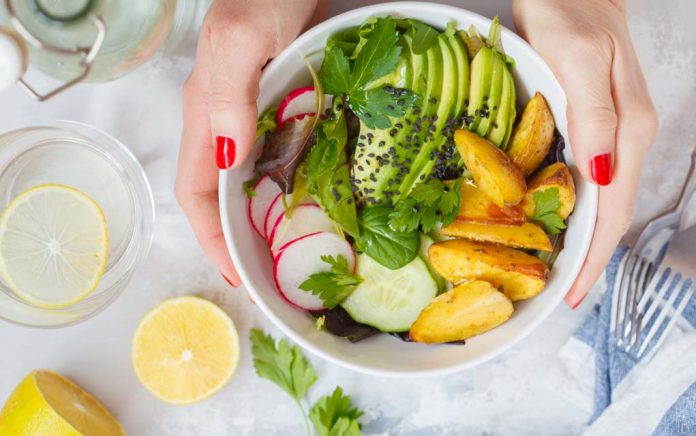
Improving your digestion is one of the most effective ways to improve health and boost energy. Making sure the nutrients you eat are well-absorbed is even more important than what you eat. Poor digestion is indicated by fatigue or lethargy after meals, bloating and gas (burping, flatulence), heartburn, acid indigestion, and acid reflux. Good digestion depends on a number of factors. Eating simple meals consisting of food combinations that do not overstep the body’s enzymatic limitations is one of the most important.
How to Improve Digestion
Avoid eating under stress or when in a hurry. The stomach has difficulty producing acid – required to digest food – when you feel anxious. Taking a few deep breaths before eating will help you relax. Salivating at the thought or sight of food is a good indication the digestive system is ready to receive food.
Read more about minimizing stress and maximizing health with a nutritious diet
1. Chew your food carefully. Chewing each bite until it’s a paste reduces the amount of work the rest of your digestive system must perform. Chewing also helps you relax and enjoy the tastes, textures and aromas.
2. Eat slowly and stop when you’re satisfied – not full. Eating slowly allows enough time for the digestive system to communicate satiety to the brain. Overeating slows digestion and encourages bad habits.
3. Avoid distractions when eating. You cannot focus on your food if you are watching television, reading, or arguing while eating. Listening to quiet music, or enjoying pleasant conversation in a relaxed environment, is conducive to good digestion.
4. Limit the amount of fluids consumed with meals to approximately 4 oz. or less at room temperature. Drink your eight glasses of water between meals. If you’re thirsty around mealtime, drink no later than ½ hour before and no sooner than ½ hour after eating. Drinking fluids with meals dilutes digestive juices and impairs digestion.
5. Avoid cold fluids with meals. Cold beverages numb the stomach’s acid-producing glands which inhibits digestion for several hours.
6. Avoid coffee or tea before and after meals. These caffeinated substances act as appetite suppressants and stimulate stomach emptying before food is completely digested. This may prevent absorption of important nutrients.
7. Take digestive enzymes with meals if necessary. Digestive enzymes are supplements that help break down foods. Enzymes may contain ingredients such as papain (from papaya), bromelain (from pineapple), amylase (digests starch), HCl (hydrochloric acid for protein digestion)*, bile (breaks down fats), and others. *Avoid enzymes containing HCl if you experience heartburn or if have an ulcer.
8. Be aware of food combinations. Mixing certain foods together may interfere with digestion. Carbohydrates are first digested by alkaline juices in the mouth, whereas proteins are broken down by acidic juices in the stomach. Eating starches and proteins together neutralizes digestive juices. Consequently, your meal will take much longer to digest. The sweeter or more refined the carbohydrate (white bread, cookies), the more it interferes with stomach acid. The heavier the protein (like red meat), the longer it takes to digest. Separating starchy carbohydrates (bread, pasta, rice, potatoes) from proteins (meat, eggs, fish) improves digestion, frees up your energy, and speeds up metabolism!
Read more about emotional eating and how to stop it
Awareness Exercise
Hold a raisin in your hands. Look at it. What does it look like? How does it smell? Place it in your mouth. Roll it around on your tongue. What does it feel like in your mouth? Now chew the raisin. Notice the various flavor sensations, changes in texture, and the levels of sweetness as you chew. Consider experiencing all your food this way!
A Journey through the Digestive System
- Digestion begins in the mouth with chewing. The salivary enzyme, amylase, breaks down starches. Food is chewed into a ball called a bolus.
- Swallowing sends the bolus through the esophagus (a long tube) by peristalsis (muscular contractions) and passes directly into the stomach.
- In the stomach, the bolus is "soaked" in hydrochloric acid (HCl) and pepsinogen, which mix together to make pepsin. Pepsin breaks apart proteins (meat, fish, eggs, nuts, beans, etc.).
- Upon leaving the stomach, food (now called chyme) enters the small intestine where final breakdown and absorption of all nutrients takes place.
- Fiber, waste, and water are all that remain of consumed food in the large intestine. This mass is "attacked" by the various bacterial strains that reside in the colon. Their action causes the body to absorb water which creates a stool.










